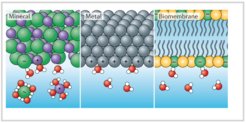Water at charged interfaces
The ubiquity of aqueous solutions in contact with charged surfaces is relevant in a variety of geological, atmospheric, and biological processes as well as technological applications, such as drug design, bioimplants, energy generation and storage.

In the environment, water plays a significant role in contact with minerals. Since the pH of water rarely matches that at which the mineral surface is neutral, surface charges are present at the interface. Mineral dissolution and growth can alter the surface charge of the mineral as well as the ionic composition of the surrounding aqueous solution, thus affecting the chemistry of these systems, such as oceans.
Furthermore, if one considers water-gas interfaces, ocean acidification caused by the dissolution of excess carbon dioxide from the atmosphere has implications for marine animals as acidic conditions affect the stability of biominerals.
In living matter, water is in contact with charged cell membranes that separate organelles and cytoplasm from the environment. The charges of the membranes affect the structure, stability, dynamics, and function of the biomembranes. For example, an important role of interfacial water at biomembranes is to support in-plane proton conductivity along the membrane, which is critical for cellular bioenergetics.
Interfaces involving charged surfaces and aqueous electrolytes are frequently encountered in electrochemical measurements and in reactions that generate (e.g., water splitting) or consume (e.g., H2 fuel cells) fuel. For example, in oxide-based photocatalytic water splitting, irradiation produces H2 from H2O at the surface of a metal oxide electrode, and the photocatalytic activity is strongly influenced by the surface speciation and pH of the solution, which in turn affect the surface charge.
All these examples from different fields show that the interaction of water with surfaces, especially the generation or modification of surface charges, plays a major role. To describe the various phenomena, an understanding at the molecular level is necessary. The review paper, now published in Nature Chemistry Reviews, summarizes the current state and limitations of our understanding and concludes with an outlook on future possibilities in this field.












